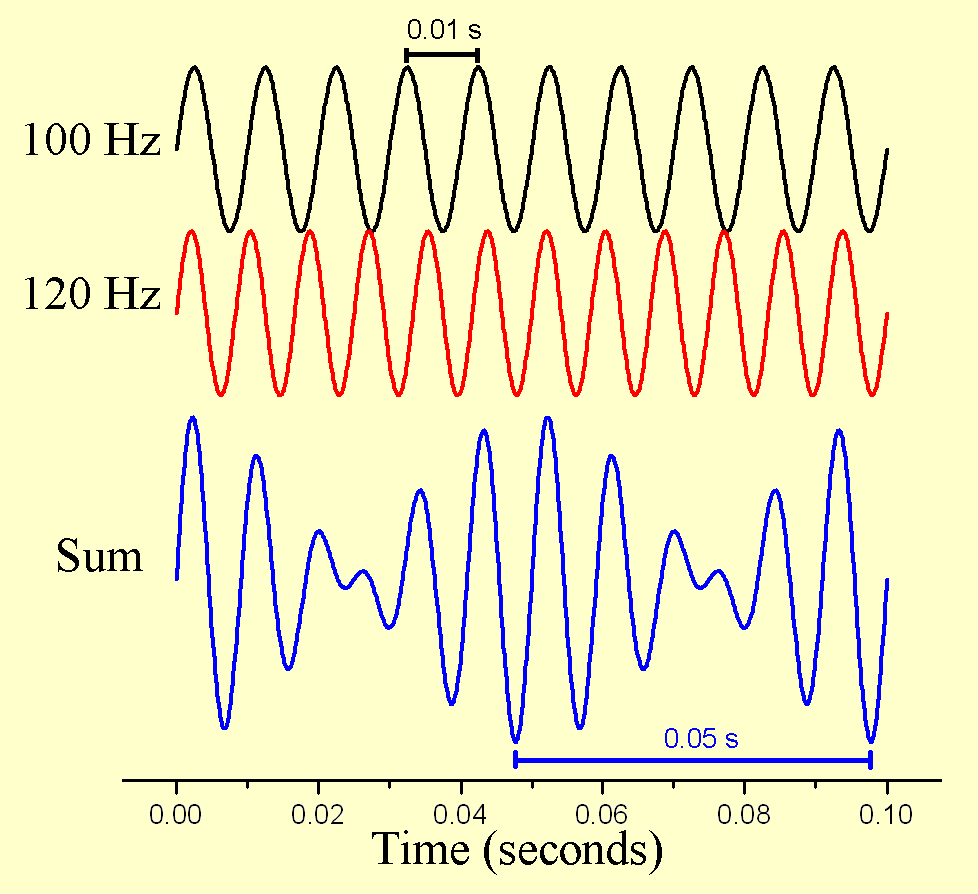
Beats
When two (or more) sounds are present having a frequency difference
of less than
about 20 or 30 Hz, you will hear "beats." The frequency of
the beats will be at the difference frequency. If the frequency
difference is larger
than about 20 or 30 Hz, a tone is usually perceived
rather than distinct beats.
For complex sounds, beats can
arise from any of the partials of the sounds.
 Mathematically beats can be understood from a mathematical identity
for sine waves. For sounds with (angular) frequencies of w1 and w2 added together the identity gives
Mathematically beats can be understood from a mathematical identity
for sine waves. For sounds with (angular) frequencies of w1 and w2 added together the identity gives
sin(w1t) + sin(w2t) = 2 sin(w3t)cos( w4t)
where w3 is the average of w1 and w2
and w4 is one half of their difference.
If the difference frequency is small, the sound is the sound of a single
tone at the average frequency, but with a volume which varies in time at
the difference frequency. This is illustrated on the graphic to the left.
The sum is a sine wave with a variable amplitude and the pattern repeats
every 0.05s. That is, there are 1/0.05 = 20 repeats per second.
You can hear beats using this
Sound File
(mp3) (
wav).
There are two pure tones near middle C which are 6 Hz apart. First each tone is
played separately using then left and right stereo channels,
then they are played together. As an interesting
experiment, listen to the sound file using a good pair of earphones. You
will hear the beats even if the tones are sent separately to your two
ears. This means your hearing system actually performs a (phase
coherent) addition of the sounds somewhere in your brain, after
the sound has been detected by your ear. The last
sound in the file has the two tones played equally in both ears.
The beats sound similar, but note also that it does not sound the
same "spatially." See the wikipedia article on
binaural
beats for more information.
Beats can be used anytime you have periodic behavior. Since it
is easy to hear beats faster than about 1 per second, it is relatively
easy to match two signals with an accuracy
of 1 Hz (or better) even if the original frequencies are
microwave signals at 1 GHz = 1,000,000,000 or above. That corresponds
to more than 12 digits of accuracy!
Questions/Comments to: suits@mtu.edu .
There are no pop-ups or ads of any kind on these pages.
If you are seeing them, they are being added by a third
party without the consent of the author.
To Physics of Music Notes
To MTU Physics Home
Copyright Info
 Mathematically beats can be understood from a mathematical identity
for sine waves. For sounds with (angular) frequencies of w1 and w2 added together the identity gives
Mathematically beats can be understood from a mathematical identity
for sine waves. For sounds with (angular) frequencies of w1 and w2 added together the identity gives
